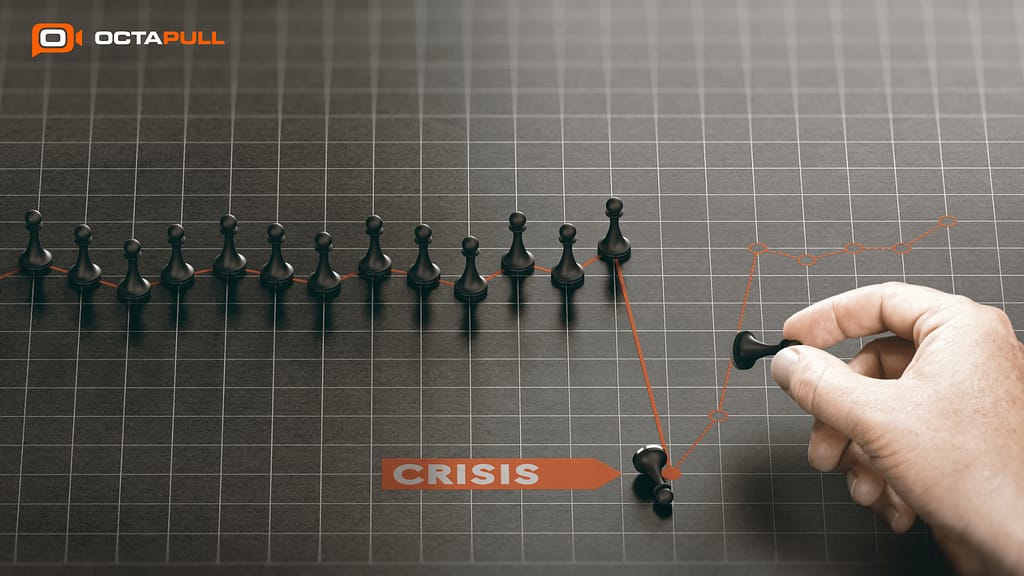Ensuring organizational resilience has become an obligation in today’s dynamic world. Central to this resilience are the concepts of business continuity (BC) and disaster recovery (DR).
While distinct, these two concepts work together to safeguard businesses from disruptions. In this article, we will explore the definitions, differences, and effective collaboration of BC and DR.
Business Continuity: Comprehensive Preparedness

Business continuity is the proactive planning and preparation to guarantee that essential business functions can continue or be quickly restored in the event of disruptions or emergencies.
Risk Assessments: Beyond the Obvious
Business continuity is not merely about fixing things when they go wrong. It also involves making plans ahead of time to keep the important parts of business running smoothly, even when problems occur.
Rather than focusing on major issues such as floods or fires, we should also look at smaller factors that could potentially cause problems. Addressing issues related to sourcing products from suppliers or adapting to changes in customer preferences can be considered as examples of these factors.
Contingency Planning: Being Ready for Surprises
Contingency planning is getting ready for unexpected problems. It involves thinking ahead and making detailed plans to handle issues effectively.
For a retail store, this could be having backup suppliers in case the usual ones can’t provide products.
Redundancy: Avoiding Weak Points
Redundancy in business continuity is similar to having a safety net beyond backup plans. Imagine a retail store as a complex system with different parts – one critical part is the customer payment process.
Instead of solely relying on a single payment system, redundancy involves strategically having extra systems in place. Thereby, if one payment system encounters an issue or fails, the business can seamlessly switch to an alternative, ensuring uninterrupted customer transactions.
This approach ensures that no single point of failure can disrupt the entire operation. This approach enhances the reliability and resilience of the retail business.
Improving Business Continuity: Achieving Maximized Outcomes
Maximizing business continuity involves implementing strategies to ensure uninterrupted operations, especially during unexpected disruptions.
Leveraging technology to improve business continuity is crucial for achieving this goal. For instance, businesses can implement cloud-based solutions for data storage and backup, enabling seamless access to critical information from any location.
Additionally, deploying robust communication tools and collaboration platforms ensures efficient remote work capabilities, allowing employees to stay connected and productive during unforeseen events, thereby enhancing overall business resilience.
Business Continuity in Remote Work
Business continuity is crucial for remote work. It ensures that organizations can maintain seamless operations and productivity even in the face of disruptions. Having a well-defined business continuity plan allows remote workers to access essential systems and data, enabling them to perform their tasks efficiently.
This is particularly important for maintaining communication, collaboration, and the overall functioning of the business when physical presence in a traditional office setting is not possible.
By prioritizing business continuity in remote work scenarios, companies can mitigate potential challenges and ensure the sustained delivery of goods and services.
Disaster Recovery: Precision in Technological Resurgence
Disaster recovery is a comprehensive planned and strategic approach designed to quickly restore critical IT systems, data, and business operations following unexpected events or disruptions.
This process involves extensive preparations, systematic procedures, and the use of backup systems to minimize downtime and maintain the smooth operation of crucial functions.
Data Backup Strategies: Safeguarding the Digital Backbone
Data backup strategies in disaster recovery are safety nets for a retail business’s digital information. This often requires having a plan in place to immediately restore important IT systems and data in the event of unforeseen complications.
Similar to creating a spare set of keys for your home, this strategy acts as a contingency plan in case the original key is lost or damaged.
A retail store keeps track of its daily sales on a computer. The store uses data backup strategies by regularly saving this sales information in more than one place. If the main computer suddenly crashes or experiences a problem, the store can recover by using the backup data.
System Restoration Protocols: Swift Recovery
System restoration protocols encompass structured steps to expedite the recovery of IT systems, thereby minimizing downtime and ensuring a smooth return to routine operations.
If the point-of-sale system in a retail store crashes, the system restoration protocol might include specific steps, such as a system reboot or migration to a backup system. These actions facilitate a quick recovery and reduce downtime.
Offsite Storage Strategies: Keeping Data Safe
Offsite storage stands as a crucial strategy involving the replication of essential digital data in a different physical location. Particularly important for disaster recovery, this approach shields data from threats such as natural disasters, earthquakes, etc., ensuring data integrity and accessibility.
Businesses can implement off-site storage by regularly storing copies of important data sets, such as sales records, on a secure cloud server. This sensible approach ensures data security and improves the overall resilience of the business in the face of unforeseen challenges.
Distinguishing Factors: Business Continuity (BC) vs. Disaster Recovery (DR)
In understanding the differences between Business continuity (BC) and disaster recovery (DR), several key factors set them apart.
Timeframe: An Integrated Approach vs. Quick Recovery Focus
Business continuity (BC) covers both short-term disruptions and long-term strategic planning. It ensures sustained operations, preparing for immediate challenges while strategically positioning for long-term resilience.
Disaster recovery (DR) prioritizes immediate actions, focusing on the swift recovery of IT systems to minimize downtime.
Focus on Risks: Comprehensive vs. Technical
BC adopts a broad perspective of risks throughout the entire business, covering operations, supply chains, and market-related concerns. This comprehensive approach ensures the business remains resilient, addressing challenges not only in the digital realm but in all aspects.
On the other hand, DR focuses specifically on addressing IT-related risks, such as system failures or cyber threats. In a financial institution, DR plans would involve protective measures for sensitive financial data and strategies for recovering from potential cybersecurity incidents.
Testing and Training: Organization-Wide Preparedness vs. IT Specifics
BC plans to ensure the whole organization is prepared through practicing and training for different situations. This could involve simulated drills for various scenarios, like natural disasters, ensuring that employees are well-prepared for potential disruptions.
For instance, in an academic institution, BC testing might simulate scenarios like earthquakes or floods to assess preparedness. In contrast, DR plans are more focused on checking and training for computer-related issues.
In a technology company, DR testing might simulate a scenario where a server stops working, assessing how the IT team responds to minimize downtime and align with broader business continuity goals.
The Collaboration of Resilience: How DR and BC Work in Tandem

In this symbiotic relationship between disaster recovery (DR) and business continuity (BC), a crucial aspect lies in their collaborative efforts to fortify organizational resilience.
Together, they form a strong defense against problems, ensuring not only the survival of the organization in tough situations but also its success afterward.
Holistic Preparedness: Planning for the Whole Picture
Holistic preparedness is akin to creating a comprehensive plan to ensure the smooth operation of a business. Business continuity acts as the principal strategy, establishing the groundwork for the operation of disaster recovery.
Consider a manufacturing facility not only ensuring a consistent supply of raw materials (business continuity) but also having a detailed plan for quickly addressing issues if a production machine malfunctions (disaster recovery). This integration ensures the continuity of the entire manufacturing operation.
Risk Management: Handling Different Kinds of Risks
While both business continuity and disaster recovery address risks, business continuity assesses a broader spectrum, including factors related to changes in the market and issues with the supply chain. In contrast, disaster recovery focuses on specifically IT-related risks.
Downtime Minimization: Quickly Getting Back to Business
Downtime minimization represents a well-coordinated performance where business continuity keeps things running smoothly, and disaster recovery steps in to cut downtime. Together, they create a robust system protecting important business functions.
A retail business ensures a steady supply of products on the shelves and has a detailed plan for promptly addressing a technical issue if the inventory management system breaks down.
This provides a seamless shopping experience for customers, as products remain available and accessible even in the face of unexpected challenges.
Strategic Resource Management: Smart Investments for Resilience
Strategic investments in both business continuity and disaster recovery involve allocating funds for backup systems, training staff, and regularly updating plans to adapt to changing threats.
Maintaining a balanced investment in both business and technical aspects ensures optimal resilience for the retail business.
Consider a manufacturing company investing in backup systems for their machinery and measuring resources to train employees in efficiently responding to technical malfunctions. By this strategy, the business ensures a prudent distribution of resources for overall resilience in manufacturing operations.
Continuous Improvement: Always Getting Better
Regularly revisiting and updating these plans is essential for ongoing improvement. This repetitive process involves adjusting strategies to changes in technology, personnel, and external risks, ensuring sustained relevance and effectiveness for the retail business.
When business continuity and disaster recovery work hand in hand, they create a strong resilience plan that helps businesses navigate today’s complex challenges.
By blending thoughtful planning, smart investments, and teamwork, organizations can not only handle disruptions but also come out stronger, more flexible, and ready for whatever comes their way.
This united approach ensures that businesses don’t just survive tough times but thrive, embodying the true spirit of resilience practically and humanly.